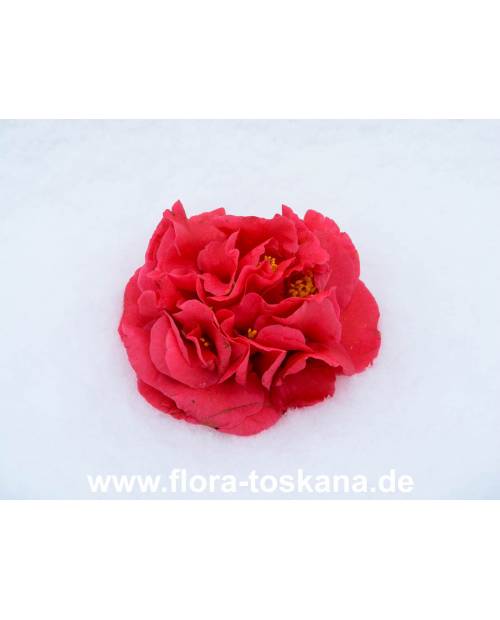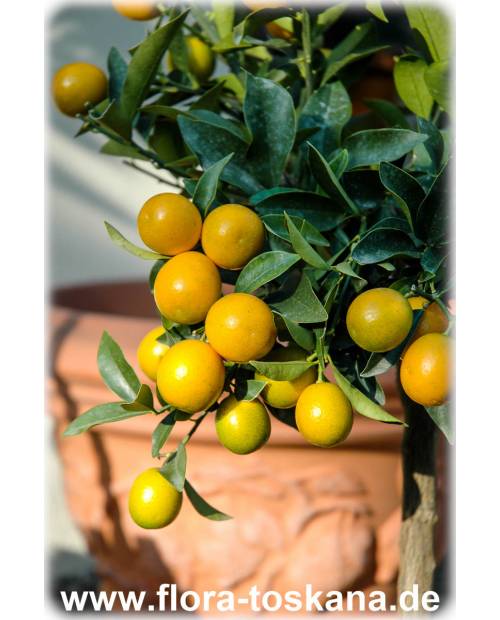Camellia japonica 'Kramer 's Supreme' - Camellia
Fragrant, densely double, red flowers characterize this hardy North American camellia cultivar (winter hardiness zone 8a).
Camellia 'Cramer’s Supreme' (Camellia japonica) tops its red, peony-like, up to 15cm across, densely double flowers with a delightful fragrance. Flowering usually starts in March- in a greenhouse it starts earlier and the effect of the fragrance is stronger than planted in the garden. This Camellia is very hardy (hardiness zone 8a: -12 °C) and therefore very suitable for the garden. It grows well branched and bushy; the annual growth is vigorous.
![]() General information on Japanese Camellia: The evergreen shrubs with the glossy, leathery dark green leaves love semi-shady places and acidic, well drained but moist, humus-rich soil as well as acidic fertilizers (e.g. rhododendron fertilizer). Their thick flower buds are already formed from (late) summer, ripen from about September until flowering in February/March/April at 0 to 10 °C, and open in cool places around 10 °C. If the temperature is too high, the buds will fall off before they open: Japanese Camellias are not houseplants! But they are wonderful winter garden plants, which rightly bear the nickname "Roses of Winter". Or – due to their surprisingly high winter hardiness, depending on the variety – they can be planted out as permanent guests in the garden, protected from the winter sun with a shade net or fleece. When planted in the garden, flowering starts (depending on the weather) a few weeks later than potted Camellia in a conservatory.
General information on Japanese Camellia: The evergreen shrubs with the glossy, leathery dark green leaves love semi-shady places and acidic, well drained but moist, humus-rich soil as well as acidic fertilizers (e.g. rhododendron fertilizer). Their thick flower buds are already formed from (late) summer, ripen from about September until flowering in February/March/April at 0 to 10 °C, and open in cool places around 10 °C. If the temperature is too high, the buds will fall off before they open: Japanese Camellias are not houseplants! But they are wonderful winter garden plants, which rightly bear the nickname "Roses of Winter". Or – due to their surprisingly high winter hardiness, depending on the variety – they can be planted out as permanent guests in the garden, protected from the winter sun with a shade net or fleece. When planted in the garden, flowering starts (depending on the weather) a few weeks later than potted Camellia in a conservatory.![]() Quality: fragrant & red & double & very large & peony-shaped & very numerous flowers; evergreen & glossy leaves; strong & bushy growth; good to very good winter hardiness
Quality: fragrant & red & double & very large & peony-shaped & very numerous flowers; evergreen & glossy leaves; strong & bushy growth; good to very good winter hardiness
![]() Use: planted in the garden; in pots from March/April outdoors in a semi-shaded place - during winter in an unheated room; all year in an unheated or rarely heated conservatory
Use: planted in the garden; in pots from March/April outdoors in a semi-shaded place - during winter in an unheated room; all year in an unheated or rarely heated conservatory
Data sheet
- Family
- Theaceae
- Origin
- Asia (mediterranean)
- Flowering period
- Winter
- Color of flowers
- Red
- Fragrance
- Fragrant flowers
- Growth
- Shrub
- Location
- Shadow
- winter temperature
- 5 (+/- 5) °C
- Minimum temperature
- -15 °C
- Hardiness Zones
- 7
- Height
- 2 - 2,5 m
You might also like
Customers who bought this product also bought:
















































